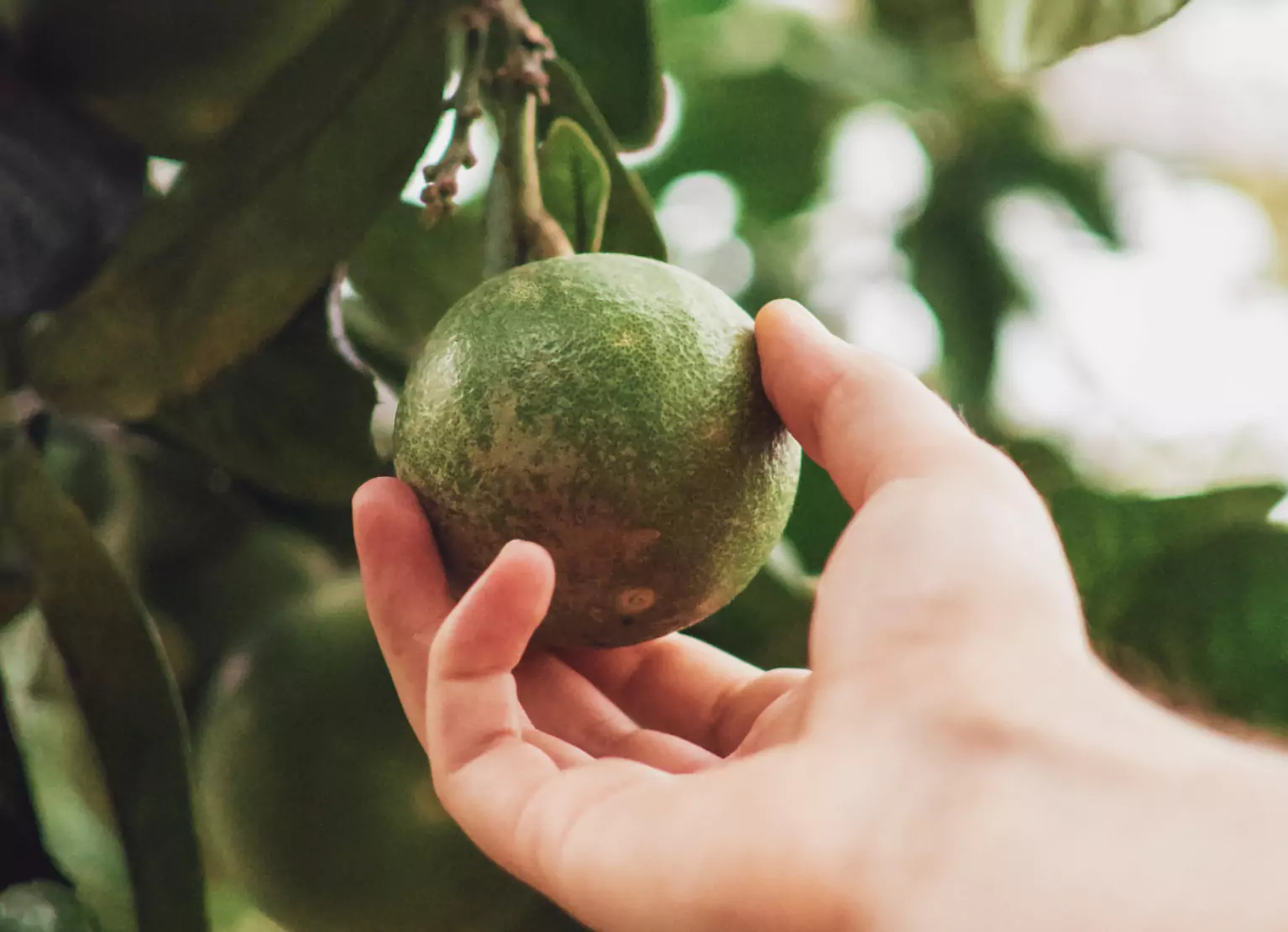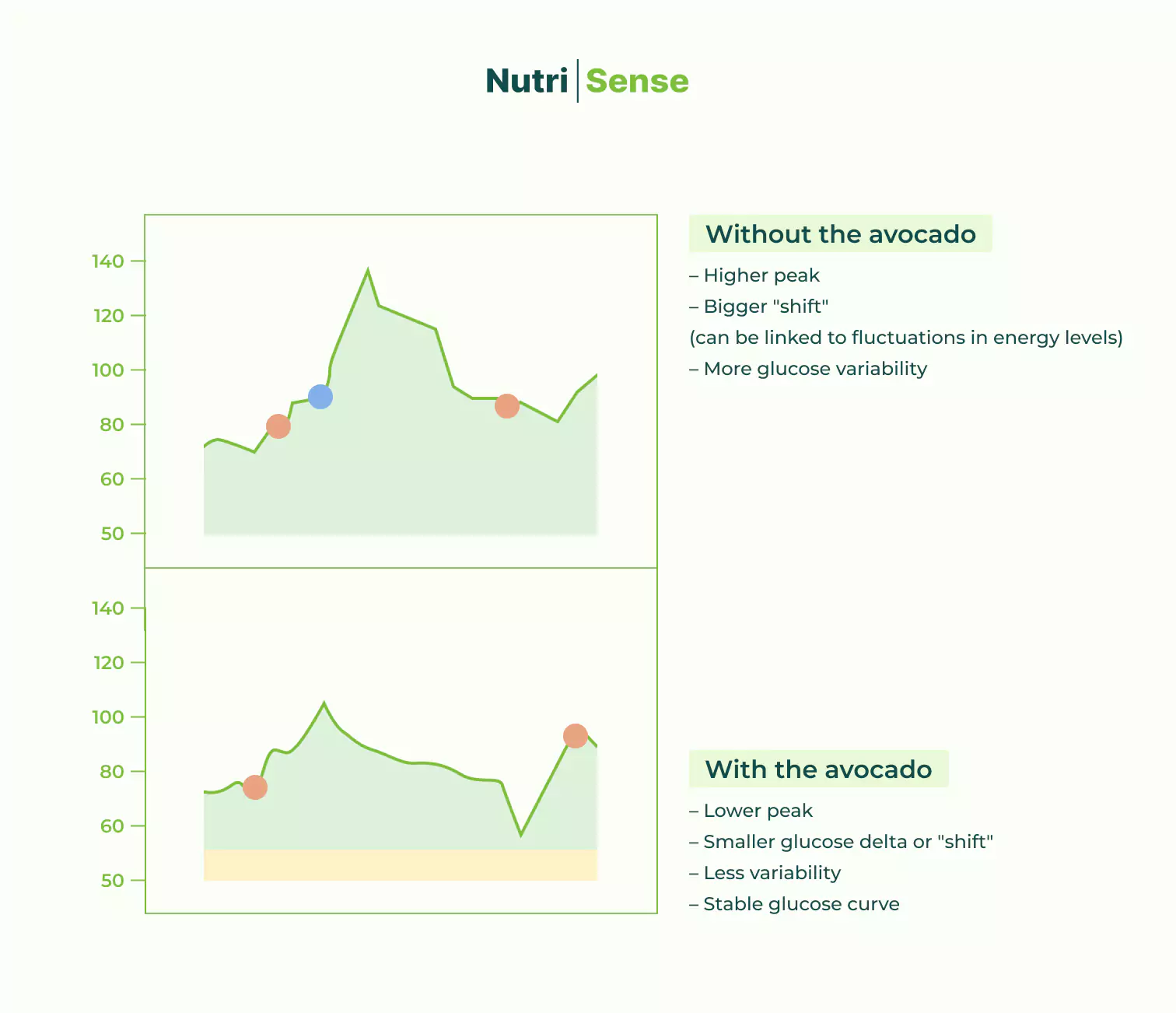Avocado and Blood Sugar: Decoding the Glycemic Index

Key Takeways
If you‘re a fan of this healthy food, you know why we‘re so excited to be talking about it. Avocados are often touted as a ‘superfood’ and are extremely popular because of their nutty or grassy taste and creamy, almost buttery texture.
Because they are not very sweet, you may think they’re a vegetable, but avocados are actually a fruit. More specifically, they‘re technically classified as berries because they have a fleshy pulp and contain a seed.
Avocados are perhaps best known as the main ingredient in guacamole. They are also popular in salads, and smoothies, eaten on their own, and are even used as a substitute for butter and oil in baked goods. This is partly because of their various health benefits, but they’re also delicious and versatile!
Beyond their great flavor, avocados also have several health benefits—and not raising your blood sugar levels may be one of them! Read on to find out more about what these benefits are, and their relationship with blood glucose levels.
Avocados and Blood Glucose

So, what effect do avocados have on blood sugar? Researchers have found that avocados do not significantly impact blood sugar levels. In fact, a 2007 study suggests that foods high in monounsaturated fats may improve insulin sensitivity in insulin-resistant people, help stabilize blood sugar, promote satiety, and even improve glucose response after eating carbohydrates.
Avocados, rich in monounsaturated fat, could be a great addition to the diet of people who have insulin resistance. Generally, avocados are considered safe for people with diabetes. Still, talk to your doctor about changing your diabetes food plan.
The Glycemic Index of Avocados

The glycemic index, or GI, system was developed as a tool for people with diabetes to make healthy food choices. The GI system assigns a number to certain goods according to how much the food will increase blood sugar.
Avocados have a glycemic index of about 40. A low GI food has a GI value of 1-55, making avocado a food low on the GI scale. However, there are limits to the GI system, and it shouldn’t be the only consideration in choosing what foods will be healthy for you. You should see this as just one tool to help you figure out what’s suitable for your individual needs.
If you're unsure whether you should add avocados to your diet or want to learn more about low glycemic index foods, talk to your doctor or dietitian.
The Nutritional Benefits of Avocados

Avocados are a nutritious fruit low in carbohydrates, so you can include them in your low-carb diet plan. Because of their high fat and fiber content, you're more likely to feel full faster after eating one.
A whole avocado contains:
- About 322 calories.
- 29 grams of fat (20 grams of heart-healthy monounsaturated fat)
- 4 grams of protein
- 13 grams of fiber
This low glycemic index food (more on that below) is also low in sugar, with only about 1.3 grams, and sodium, with only 14 milligrams. They contain no cholesterol.
Monounsaturated Fat
You may have heard that avocados have a lot of fat. It’s true, but most of their fat content is monounsaturated fat.
According to the Academy of Nutrition and Dietetics, the majority of fats in a heart-healthy diet should be monounsaturated or polyunsaturated fats.
Monounsaturated fat can help reduce bad cholesterol levels, lowering your risk of heart disease and stroke. Monounsaturated fats also contain vitamin E, an antioxidant that most Americans (over 90 percent, according to recent research) don’t get enough of in their diet.
B Vitamins
Avocados are a source of several B vitamins, necessary nutrients that help turn your food into energy. They contain thiamin, also known as vitamin B1. Thiamin can:
- Keeps your nervous system functioning smoothly
- May also strengthen the immune system
- Helps the body’s cells convert carbohydrates into energy
- Is essential for the functioning of the heart and muscles
Avocados also contain Riboflavin. Also known as vitamin B2, Riboflavin is an antioxidant that fights free radicals, particles in the body that can damage your cells and DNA.
Antioxidants may reduce or prevent some of the destruction these free radicals cause in the body. Riboflavin is also vital for maintaining healthy vision.
Avocados are rich in pantothenic acid (vitamin B5) and niacin (vitamin B3). Like other B vitamins, niacin and pantothenic acid are crucial in turning the food you eat into energy and keeping your nervous system healthy.
Pantothenic acid is also essential for metabolic functions like making and breaking down fats. At the same time, niacin is necessary for the development and function of your cells.
Fiber

Avocados are high in fiber, containing about 13 grams in a whole avocado. Fiber is essential in maintaining a healthy and functioning digestive system. Fiber isn’t digested by the body, bulking up your stool and making it easier to pass through your body.
A diet high in fiber can help you maintain a healthy weight, prevent hemorrhoids and diverticular disease, and help control blood sugar levels.
Potassium
Avocados are rich in potassium, a mineral that your body relies on for several body functions and that most people in America don’t get enough of.
You need potassium for proper kidney, heart, and nervous system function. Potassium may also counter the effects of sodium on your blood pressure.
Vitamin C
Avocados contain a lot of vitamin C, another antioxidant that helps protect your cells against harmful free radicals. Vitamin C also helps your body form blood vessels, cartilage, muscle, and the collagen found in bones.
A diet rich in vitamin C can also potentially prevent cancer, age-related macular degeneration (an eye disease that blurs your vision), and cataracts.
{{rich-text-cta-cgm1="/style-guide"}}
Potential Risks of Avocados

So avocados are high in necessary nutrients, so they may be a good option to help lower risk factors for various health conditions. But are there any health risks? Read on to find out.
Saturated Fat
While most of the fat in avocados can be beneficial for overall health, an avocado does contain about four grams of saturated fat. While whole food sources of saturated fats are not inherently bad, you may want to monitor your consumption of these fats if you’re at risk for conditions such as high cholesterol or heart disease for some individuals.
Saturated fats are found in animal products like:
- Beef
- Pork
- Poultry
- Eggs
- Full-fat dairy products
- Tropical oils (like coconut oil)
Avocado and Latex Allergies
If you are allergic to latex, you may also want to avoid avocados. Curiously, avocados contain the same allergens found in latex.
If you’re allergic to latex, there is a high chance you could also be allergic to avocados, so talk to your doctor if you experience allergy symptoms like itching your mouth or throat after eating an avocado.
Environmental Impacts of Avocados
Avocados are healthy and delicious, but you may want to consider where they're grown and how.
The commercial growing of avocados has a high environmental impact. Avocados need a lot of water to grow, and they are typically grown in regions of the world where water resources are limited.
And because the fruit travels long distances to reach consumers in the United States, avocados have a high carbon footprint.
For this reason, it could be a good idea to buy locally-grown avocados as much as possible.
Adding Avocado To Your Diet
Avocados are incredibly versatile and can be eaten in sweet or savory dishes, so don’t hesitate to add them to your meal plan. This fruit has many health benefits, including managing prediabetes, lowering blood pressure, adding dietary fiber to your diet, preventing blood sugar spikes, and helping with cognitive health and heart health.
Here is an experiment from one of our members at Nutrisense, Stuart Tutler, who learned that he needs more healthy fats in his smoothie.
In picture one, you can see his response to his smoothie when he added the avocado to his smoothie. In picture two, you can see how his blood sugar spiked when he didn’t add the avocado.
His dietitian, Yvonne M. tells us, “In picture one, Stuart enjoyed a smoothie with almond milk, two ounces of avocado, cocoa plant-based protein powder, cymbiotika red yeast rice, and peanut butter."
As you can see on the graph, he had a great response! His glucose only increased 20 points, and there was no large glucose peak. In the second image, you can see Stuart enjoyed the same smoothie, only he did not add the avocado. His glucose went up 35 points, and he had a peak of 140.
So why did a similar smoothie have such different responses?
Yvonne explains, “The two ounces of avocado provided healthy fat and some extra fiber to his smoothie! Fat and fiber slow down digestion, which creates a smaller glucose curve!”

Heather’s Tips on How to Pick an Avocado
Here are a few more tips from Nutrisense dietitian Heather Davis, MS, RDN, LDN, to help you pick the perfect avocado.

5 Avocado Recipes We Love
If you're excited to eat more delicious avocado, here are are five of our favorite avocado recipes to try making at home!
1) Guacamole from The Modern Proper

There is nothing like homemade, fresh guacamole. This recipe from The Modern Proper is easy to make and takes just 15 minutes!
Ingredients:
- 3 medium garlic cloves, finely chopped
- 1 teaspoon freshly ground black peppercorn
- 3 ripe avocados
- ½ jalapeno pepper, finely chopped
- ¼ cup red onion, finely minced
- ½ cup cilantro leaves, chopped
- 2 tablespoons fresh-squeezed lime juice
- ½ teaspoon coarse salt
What Heather Thinks:
This is a classic guacamole recipe, so it’s hard to go wrong! For the best dipping companion that will go easy on your blood sugar, I like to recommend some lower-carb chip options such as parmesan crisps or zucchini chips (either baked or cooked in the air fryer).
2) Avocado Sweet Potato Tacos from Love & Lemons
This simple vegetarian recipe from Love & Lemons takes 30 minutes to make and would make a delicious meal for any season.
Ingredients:
- 1 medium sweet potato, cubed
- Extra-virgin olive oil
- ½ teaspoon chili powder
- 4 to 6 tortillas
- 1 cup black beans, cooked, drained, and rinsed
- Lime slices, for serving
- ½ cup whole milk Greek yogurt
- 1 small avocado
- ½ garlic clove
- Juice of 1 lime
- Sea salt & fresh black pepper
- 1 small avocado, diced
- 2 scallions, diced
- Crumbled feta cheese
- Pickled onions
- Micro greens or fresh cilantro
What Heather Thinks:
The total carbs in this meal might be a little bit on the higher side due to the combination of the sweet potato and beans, especially if you’re opting for a higher-carb tortilla option.
You may try subbing in a lower-carb tortilla and throwing in a bit more protein, perhaps from some tofu, to improve glucose response.
3) Avocado Chicken Salad from Delish

This recipe from Delish is great on its own but can also be served in a chicken salad sandwich.
Ingredients:
- 2 boneless, skinless chicken breasts, poached and cut into bite-size pieces
- 2 avocados, cubed
- 1 small mango, cubed
- 1 cup grape tomatoes, quartered
- ½ cup fresh or frozen corn
- ¼ red onion, thinly sliced
- ¼ cup lime juice
- 3 tablespoons extra-virgin olive oil
- 2 tablespoons freshly chopped cilantro
- 1 tablespoon minced jalapeño
- 2 teaspoons honey
- Kosher salt and freshly ground pepper
What Heather Thinks:
This is loaded with a lot of great nutritional variety. However, if you're worried about the slightly higher carb content attributed to the combination of mango, honey, corn, and tomatoes, I'd recommend dropping out the honey and experimenting with how much mango and corn work with your body's glucose response.
4) Veggie, Pineapple, and Avocado Smoothie from California Avocado
This refreshing smoothie is healthy, filling, and great for hot summer days.
Ingredients:
- 1 cup coconut water
- 1 cup fresh or frozen pineapple pieces
- ½ cup cucumber slices
- 1-inch by ¼-inch ginger slice, peeled
- 2 cups baby spinach leaves
- ½ ripe, fresh California avocado, seeded, peeled, and cubed
- 1 scoop vanilla protein powder (whey, soy, pea, or rice)
What Heather Thinks:
The protein powder in this recipe may help offset some of the glucose response brought on by the sugar in the pineapple and coconut water, but if you want to minimize that response further, I'd recommend swapping the pineapple out for berries (which tend to be lower in sugar).
You can also try reducing the amount of coconut water and replacing it with regular water or ice, or even swapping out the protein powder for whole food-based protein sources like Greek yogurt, cottage cheese, or even silken tofu, which might help blunt your glucose response more than a protein isolate and will also have more nutritional value.
5) Avocado Pesto from Detoxinista

This healthy alternative to traditional pesto would be great on pasta, toast, or to dress a salad.
Ingredients:
- 1 cup fresh basil, tightly packed
- ½ cup water
- 2 tablespoons fresh lemon juice (about 1 lemon)
- 2 cloves garlic
- 1 ripe avocado
- ¼ teaspoon sea salt, or more to taste
What Heather Thinks:
This recipe is simple and great! I'd recommend pairing it with a protein-rich pasta dish such as baked chicken and buckwheat soba. Or, if you're looking for other healthy noodle or pasta alternatives, check out our article on healthy noodles.
Find the right Nutrisense programto turn insight into progress.
Go Beyond Glucose Data with Nutrisense
Your glucose can significantly impact how your body feels and functions. That’s why stable levels are an important factor in supporting overall wellbeing. But viewing glucose isn't enough. Nutrisense, you’ll be able to learn how to use your body's data to make informed lifestyle choices that support healthy living.
One-to-one coaching
Sign up to access insurance-covered video calls to work with a glucose expert: a personal registered dietitian or certified nutritionist who will help tailor your lifestyle and diet to your goals.
Monitor and measure what matters
With the Nutrisense CGM Program, you can monitor your glucose with health tech like glucose biosensors and continuous glucose monitor (CGM)s, and analyze the trends over time with the Nutrisense App. This will help you make the most informed choices about the foods you consume and their impact on your health.
Find your best fit
Ready to take the first step? Start with our quiz to find the right Nutrisense program to help you take control.

Carlee's training at Western Illinois University and an internship at the Memphis VA Hospital lead her to a career in outpatient counseling and bariatric nutrition therapy. In these positions, Carlee realized many of the disease states (upwards of 80%!) her patients experienced were actually preventable. She knew she had to dig deeper into preventative health and has since been passionate about helping people translate this complex glucose data into actionable changes anyone can implement into their everyday lives.




